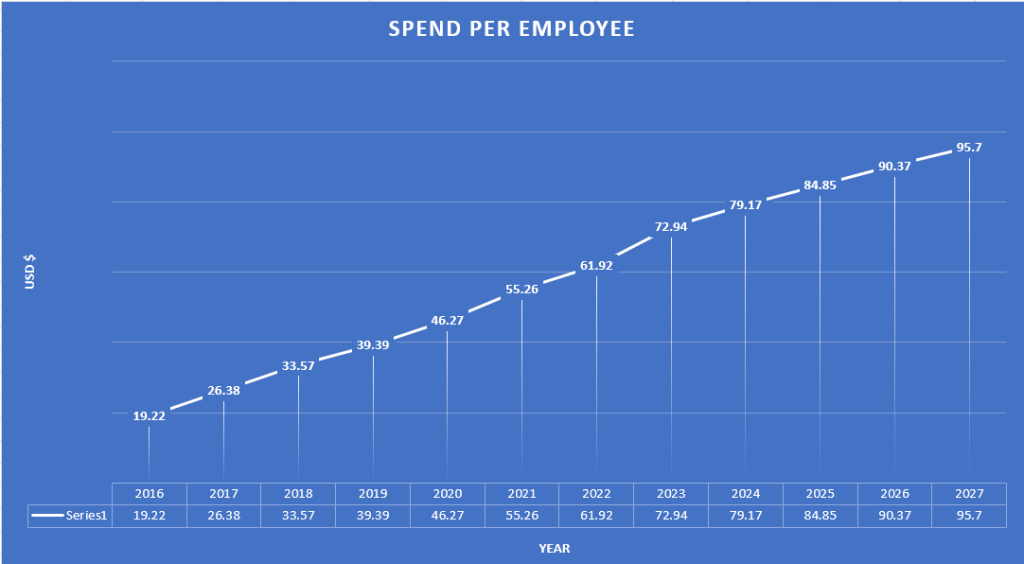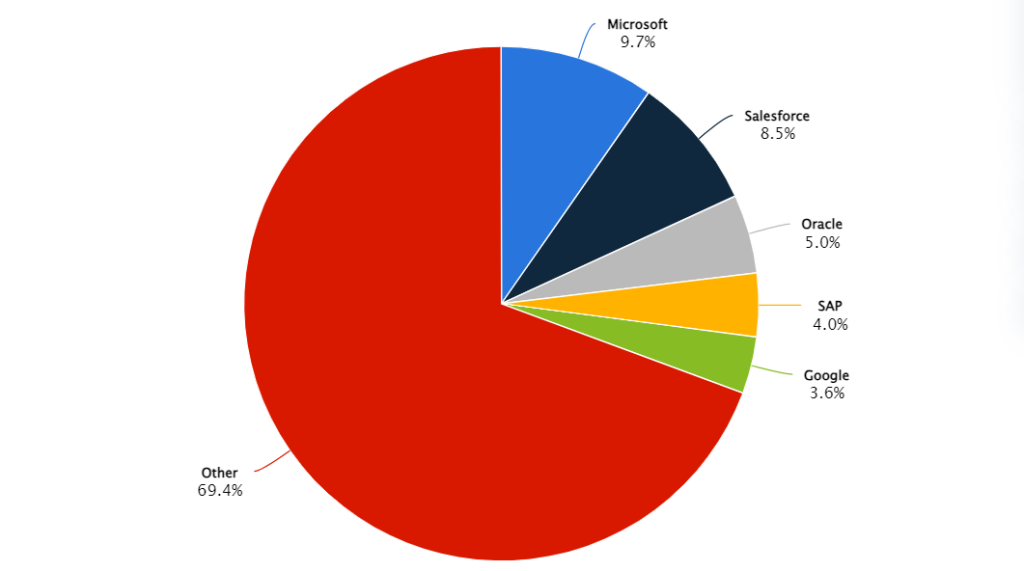What is the SaaS Market Outlook?
The SaaS market outlook refers to the current and future state of the Software as a Service (SaaS) industry. SaaS is a software delivery model in which software is hosted on the cloud and accessed over the internet. It is a popular model for delivering business applications, and its importance in the technology industry cannot be overstated. SaaS has revolutionized the way software is delivered and consumed, and it has become a key driver of growth in the technology industry.
SaaS Market Outlook: An Overview

- SaaS is defined and its importance in the technology industry is highlighted.
- The article provides an overview of the purpose and scope of the article.
- Understanding the SaaS market outlook is emphasized.
SaaS Market Size and Growth
- Current and projected SaaS market size is discussed.
- Factors driving the growth of the SaaS market are outlined.
- The impact of COVID-19 on the SaaS market is analyzed.
SaaS Market Segmentation
- The SaaS market segments are introduced.
- Growth trends and opportunities in each segment are explained.
- Case studies of successful SaaS companies in each segment are provided.
SaaS Market Size and Growth
According to a report by Fortune Business Insights, the global SaaS market size was valued at USD 237.48 billion in 2022. The report also predicts that the market will grow from USD 273.55 billion in 2023 to USD 908.21 billion in 2030, with a compound annual growth rate (CAGR) of 18.7%.

Image and data source: Statista
The growth of the SaaS market is being driven by several factors, including the adoption of cloud-based solutions, integration with other tools, and data-driven analytics. The COVID-19 pandemic has also increased the demand for cloud-based services due to remote work policies. However, the lack of security for sensitive data may hinder market growth.
SaaS Market Segmentation
The SaaS market can be segmented into several categories, each with its own growth trends and opportunities. The CRM segment is one of the largest and fastest-growing segments of the SaaS market. The growing demand for customer engagement and customer experience management is driving the growth of the CRM segment. The ERP segment is also a significant contributor to the SaaS market, with a focus on streamlining business processes and improving operational efficiency. The HRM segment is another growing segment of the SaaS market, with a focus on talent management and workforce planning.
Successful SaaS companies in each segment include Salesforce, Oracle, SAP, and Workday in the CRM segment; SAP, Oracle, and Microsoft in the ERP segment; and Workday, SAP, and Oracle in the HRM segment. These companies have been able to grow by providing innovative solutions that meet the needs of their customers.
| Region | Key Players | Market Size | Growth Trends | Opportunities | Challenges |
|---|---|---|---|---|---|
| North America | Salesforce, Adobe, Microsoft | USD 237.48 billion (2022) | Dominating market share | Growing demand for cloud-based solutions | Lack of security for sensitive data |
| Europe | SAP, Oracle, Adobe | Projected to reach USD 203.84 billion by 2026 | Increasing adoption of public cloud services | Increasing competition | |
| Asia Pacific | Alibaba Cloud, IBM, Google | Projected to reach USD 194.93 billion by 2026 | Shift towards SaaS from on-premises software deployment | Need for continuous innovation | |
| Middle East & Africa | Salesforce, Google | Projected to reach USD 26.34 billion by 2026 | Rapid growth in the SaaS market | Lack of awareness about SaaS solutions | |
| South America | Salesforce, Google | Projected to reach USD 13.25 billion by 2026 | Rapid growth in the SaaS market | Lack of awareness about SaaS solutions |
Regional Analysis of the SaaS Market
The SaaS market is dominated by North America, which accounts for the largest share of the market. Europe, Asia Pacific, the Middle East & Africa, and South America are also significant contributors to the SaaS market. The growth of the SaaS market in each region is affected by several factors, including the adoption of cloud-based solutions, government policies, and the level of competition.

Successful SaaS companies in North America include Salesforce, Adobe, and Microsoft. In Europe, successful SaaS companies include SAP, Oracle, and Adobe. In Asia Pacific, successful SaaS companies include Alibaba Cloud, IBM, and Google. The Middle East & Africa and South America are also experiencing significant growth in the SaaS market, with successful companies including Salesforce and Google.
Key Players in the SaaS Market

The SaaS market is highly competitive, with several major players dominating the market. These players include Adobe, Microsoft, Alibaba Cloud, IBM, Google, Salesforce, Oracle, SAP, and VMware. These companies have been able to grow by providing innovative solutions that meet the needs of their customers. They have also been using merger and acquisition strategies to expand their reach.
SaaS Market Challenges and Opportunities
The SaaS market faces several challenges, including the lack of security for sensitive data, the need for continuous innovation, and increasing competition. To address these challenges, companies need to focus on providing secure and reliable solutions, investing in research and development, and building strategic partnerships.
The SaaS market also presents several opportunities for growth and expansion. These opportunities include the growing demand for cloud-based solutions, the increasing adoption of public cloud services, and the shift towards SaaS from on-premises software deployment. Small and medium enterprises are also rapidly adopting SaaS, presenting opportunities for companies to expand their customer base.
Future of the SaaS Market
Case Study: How SaaS Helped a Small Business to Grow
John, the owner of a small accounting firm with a staff of 10, struggled to keep up with the growth of his business. He knew he needed to upgrade his technology to stay competitive and boost productivity. John decided to move from traditional desktop software to a cloud-based SaaS solution. He chose a SaaS accounting software that allowed him to access his data from anywhere and collaborate with his team in real-time.
After the implementation, John saw an immediate impact on his business. His team was able to work more efficiently, and his clients were impressed with the increased level of service. The software provided features such as automatic invoicing and payment reminders that saved John and his team hours of work each month. This allowed John to focus on growing his business and taking on new clients.
With the help of SaaS, John’s business grew by 50% in just two years. He was able to expand his team and increase his revenue. John believes that without SaaS, he would have struggled to keep up with his competitors and would have had to turn down new business opportunities.
John’s story shows how SaaS can help small businesses grow and succeed in a competitive market. The flexibility and accessibility of SaaS solutions can help businesses of any size to improve their productivity and efficiency.
The future of the SaaS market looks bright, with several emerging trends and technologies driving growth. These trends and technologies include artificial intelligence, machine learning, and the Internet of Things. The SaaS market is also expected to see significant growth in the healthcare sector, with the market for Software as a Medical Device (SaMD) expected to grow.
According to a report by Grand View Research, the global SaaS market is projected to grow at a CAGR of 13.7% from 2023 to 2030, reaching a value of USD 819.23 billion. The report also highlights the increasing adoption of public cloud services and the shift towards SaaS from on-premises software deployment as key drivers of market growth. In short SaaS market outlook is very positive.
Conclusion: Summary and Call to Action
In conclusion, the SaaS market outlook is an important area of focus for businesses and investors. Understanding the current trends and future implications of the SaaS market can provide valuable insights into the growth and direction of the technology industry.
The SaaS market presents significant opportunities for growth and expansion, but it also faces several challenges. By focusing on innovation, strategic partnerships, and providing secure and reliable solutions, companies can overcome these challenges and take advantage of the opportunities presented by the SaaS market.
As we have seen, the SaaS market is projected to grow significantly in the coming years, presenting opportunities for businesses and investors. To capitalize on these opportunities, businesses and investors should stay up-to-date with the latest trends and developments in the SaaS market.
By investing in the SaaS market, businesses and investors can position themselves for growth and success in the technology industry. However, it is important to consider the ethical implications of the growth of the SaaS market, particularly related to data privacy and security.
Frequently Asked Question
Who can benefit from understanding the SaaS market outlook?
Anyone interested in investing in or using SaaS technology.
What is the current outlook for the SaaS market?
The SaaS market is projected to reach $220 billion by 2022.
How can understanding the SaaS market outlook help businesses?
It can help businesses make informed decisions about SaaS investments.
What potential challenges might arise in the SaaS market?
Competition and changing technology could be potential challenges.
How can businesses stay competitive in the SaaS market?
By offering unique and valuable features and constantly innovating.
What if a business is hesitant to invest in SaaS technology?
They may miss out on the benefits and fall behind their competitors.







